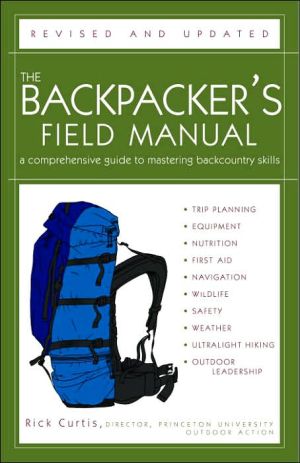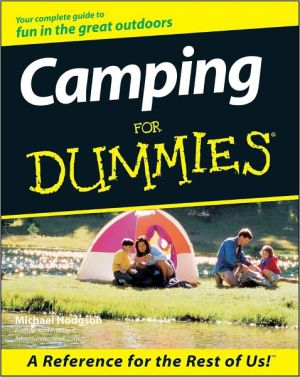The Backpacker's Field Manual, Revised and Updated: A Comprehensive Guide to Mastering Backcountry Skills
When it was first published in 1998, The Backpacker's Field Manual set the standard for comprehensive backpacking books. Now exhaustively updated to offer a more complete view of backpacking today, it covers the latest developments in gear—such as Global Positioning Systems and ultralight hiking equipment—first aid, and Leave No Trace comping, and includes a chapter devoted to outdoor leadership resources and basics. Beginners and experienced hikers alike will find this book indispensable for...
Search in google:
Chapter 1: Trip Planning\ BASIC TRIP PLANNING\ •Group Size and Ability\ •Activities\ •Location and Weather\ •Expect the Unexpected\ •Equipment\ •Food\ •Costs\ •Skill Development\ TRIP PREPARATION CHECKLIST\ •Pre-Trip\ •During the Trip\ •On Your Return\ ROUTE DIFFICULTY\ •Trip Difficulty Rating\ PLANNING A ROUTE\ •Guidebooks\ •Travel Logistics\ •Choosing Campsites\ •Estimating Travel Times\ •Time Control Plan\ LONG-DISTANCE TRIPS\ •Resupply Issues\ GOING ULTRALIGHT\ BASIC TRIP PLANNING\ Planning a trip requires more than simply deciding where to go and when. Whether it’s a weekend trip with friends, a formal outdoor program, or a major expedition, you need to evaluate your trip across a number of categories and develop a solid plan. One or two people may take on the role of planner, or the process of planning can be spread out among the entire group. I’ve planned and run trips for thousands of people both around the United States and around the world. Here are the elements you should keep in mind when planning any trip.\ \ GROUP SIZE AND ABILITY\ Whenever you’re planning a trip, you need to determine if the route should fit the group or the group fit the route. The group may have a range of experience levels, physical conditions, and goals, in which case, your goal should be to plan a trip that is appropriate for everyone. Other times, you may have a specific trip you want to do that may be challenging or require special skills. For this kind of trip, you need to select a group that has the right qualifications to participate. Here’s a checklist of questions to ask when planning a group trip:\ •What kind of group is it? Is it an informal group of friends or a formal group like an outdoor education program? Are the participants friends, students, volunteers, or paying customers? Formal groups may have specific policies and protocols that must be followed.\ •What are the goals of each group member? Are people required to attend? (This factor can have a significant impact on how committed or not the group is to the wilderness experience.) Does the group have collective goals?\ •What is the experience level of each member? What is the average experience level?\ •Are there people in the group with the necessary skills to lead and manage the group or do you need to find other people to provide leadership? (See Appendix, “Outdoor Leadership.”)\ •How big is the group?\ •What is the age range of group members?\ •What is the physical condition of each member? What is the average physical condition of the group?\ •Do people have particular health issues that could impact their participation?\ Determine the level of experience, physical ability, etc., as much as possible before you set out. This will enable you to plan a smoother and more successful trip. More important, it will diminish the potential for dangerous situations. (See Chapter 8, “Safety and Emergency Procedures.”) Keep the group’s parameters in mind as you evaluate the other categories, thinking in terms of both optimal challenge and safety. Be aware that you will often have a great range of experience levels and physical abilities, so plan the trip at a level that will be fun, educational, challenging, and safe for everyone. Think about the high end and the low end of the experience level and physical condition, and err in the direction of the low end. Gathering physical fitness and basic health information will help you determine different abilities and experience levels (for a sample form, see page nnn).\ Group Dynamics\ •How are costs going to be handled—equipment, food, transportation, permits, etc.? If you have to buy gear, who keeps it? It’s really important to work these things out before the trip, otherwise serious tensions can arise later.\ •How will leadership be handled during the trip? (See Chapter 8, “Safety and Emergency Procedures,” and Chapter 10, “Outdoor Leadership”).\ \ ACTIVITIES\ When planning the activities for a particular trip, you need to consider the following:\ •What activity(ies) do you want to do on your trip (backpacking, peak climbing, and/or glacier travel, for example)?\ •What are the goals for the trip?\ •What skills will people need? Do they already have the skills or do they need to learn them?\ •How do you integrate time for teaching skills with time for traveling?\ Once you’ve evaluated the group members’ abilities, you can adapt your goals to an appropriate level. Plan activities that will be both appropriately challenging and safe. Be aware of how mileage, elevation change, and time for teaching and learning skills will affect your route (see “Estimating Travel Times,” page 12). Start easily and increase the level of difficulty gradually so that participants can be progressively challenged at appropriate levels, rather than placing them in a situation that is beyond their abilities.\ LOCATION AND WEATHER\ Research Your Destination\ •Investigate the availability of guidebooks and maps.\ •Contact area rangers or land managers to get more information. Inquire about permits required, safety issues like hunting season, and seasonal hazards like wildfires.\ •Talk with other people who have been to the area before. If possible, check their trip logs, which may have important information not found in guidebooks.\ Trip Planning Questions\ •How long is the trip? Can the trip be self-supporting in terms of equipment and food, or will you need to resupply? How will you do the resupply—cache items ahead of time, hike out, or have someone hike in? (See “Resupply Issues,” page 15.)\ •How remote is the trip from “civilization” and help in case of an emergency?\ •What are the trail conditions?\ •Are there special places you want to see?\ •Are there places you want to avoid like high-use areas?\ •Are shelters available on a daily basis, or do you need to bring your own?\ •Where is parking and trailhead access?\ •What is the water availability and water quality on a daily basis?\ •Are there safety issues—hunting season, off-road vehicles, etc.?\ •Are there any special natural hazards—flash floods in desert canyons, wildfires, etc.? (See “How Accidents Happen,” page 225.)\ •What Leave No Trace practices will you need to implement to safeguard the environment? (See Chapter 5, “Leave No Trace Hiking and Camping.”)\ Regulations and Permits\ Each location can have its own unique set of regulations and requirements. It is important to check these out in detail before you go.\ Here are some of the possible issues to research:\ •Are permits needed, and how do you obtain them?\ •How far in advance do you need to apply for a permit?\ •Is there a cost for the permit?\ •Are their any special regulations about rescue? (Some parks, like Denali in Alaska, require that you pay for your own rescue.)\ •Are there limitations to group size?\ •Where is camping allowed and not allowed?\ •Are there any restricted areas, hazardous zones, protected areas for endangered species, and such?\ •Are fires allowed? If fires are allowed, will wood be available? Or will you need to bring a stove?\ •Are there special regulations about Leave No Trace practices such as disposing of human waste?\ Weather\ •How many hours of daylight will there be? Check the Web at sites like the Weather Channel (www.weather.com) for sunrise and sunset times and average high and low temperatures.\ •How will the season determine the weather? Are storms or particular weather patterns likely? (See Chapter 7, “Weather and Nature.”)\ •How will weather affect trip activities? How might it affect the safety of the group?\ •Will altitude changes during the trip have an impact on weather or temperature?\ EXPECT THE UNEXPECTED\ When planning a trip, remember that the ultimate goal is for people to have fun. Here are some tips to planning a trip that everyone can enjoy:\ •Make a plan that can be modified during the trip. All sorts of factors—bad weather, changing trail conditions, broken equipment, ill-prepared participants, an injury—may require you to change your itinerary.\ •Don’t plan long or difficult hikes on every day of the trip. Vary the mileage so that you have some days when you can get a later start or get to camp early.\ •On longer trips, schedule a rest day every five to seven days.\ •Make sure that people have some time during each day to kick back—to read, watch the sunset, or write in their journals.\ •When hiking at high altitudes, people acclimatize at different rates. You may have to adjust your trip to give people time to properly acclimatize before going higher, especially if people are coming straight from sea level to a high altitude. (See “Altitude Illnesses,” page nnn.)\ \ EQUIPMENT\ Once you have determined your trip activities and location, you need to put together an equipment list. Sample equipment lists are are provided in Appendix A, but remember that they should be used only as guidelines. Each trip and each person may have special requirements.\ FOOD\ It is important to have food that is both nourishing and edible. On longer trips, with specialized activities, or in different climates (e.g., cold-weather trips), it may be necessary to plan a menu that supplies a specific number of calories per day and stresses certain food groups over others. On any trip, it is essential to be aware of special dietary requirements for each trip member—food allergies, vegetarians, and kosher eaters—and plan a menu accordingly. Check this information on the Fitness and Health Information Form for each person on the trip (see page nnn). For complete food, nutrition, and menu planning guidelines, see Chapter 3, “Cooking and Nutrition.”\ \ COSTS\ Before going on a group trip, talk about how costs will be distributed. This includes food, fuel, travel expenses, and first aid supplies. You’d be surprised how many friendships get strained because people did not work out the finances beforehand.\ SKILL DEVELOPMENT\ Depending on the type of group you’re traveling with, people may have varying levels of experience. There are specific skills that people need before the trip, such as how to pack a pack, and some that need to be taught on the trip, such as how to set up camp or how to use a backpacking stove. There are so many different skills I use on a backcountry trip that I find it hard to remember them all—many I just do automatically. Take the time to make a list of these skills so you don’t overlook anything (a sample Teaching Plan is included in Appendix A). If you are the trip leader, or if you’re just traveling with friends who are less experienced, plan time to cover the important subjects both ahead of time and on the trail.\ For advanced-level trips, you may need to do a more formal skill assessment. For example, if you are going to be traveling across glaciers, does everyone have experience traveling on snow, handling an ice axe, and being roped up? Will people need to know special techniques like self-arrest or crevasse rescue? Sometimes this assessment is done by reviewing people’s previous trip experiences, or you may have the group go out on a supervised practice trip to review and test special skills.







